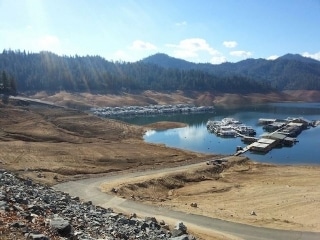Mar 1 2019
A new study, published in the AGU journal Earth’s Future, reports that population growth and climate change are the major issues in some of the regions of the United States that would cause water scarcity by the end of the 21st century.
 Lake Shasta, the largest manmade lake in California, was at 36% capacity when this photo was taken in January 2014. A new study shows climate change plus population growth are setting the stage for water shortages in parts of the U.S. long before the end of the century. (Image credit: USGS/Angela Smith)
Lake Shasta, the largest manmade lake in California, was at 36% capacity when this photo was taken in January 2014. A new study shows climate change plus population growth are setting the stage for water shortages in parts of the U.S. long before the end of the century. (Image credit: USGS/Angela Smith)
According to the researchers involved in this novel study, it is difficult to prevent water shortages despite effective measures taken to use water more efficiently in industrial and municipal sectors. The outcomes of this study indicate that a decrease in the usage of water for agriculture can likely play a major role in restricting water shortages in the future.
This study is part of a larger 10-year U.S. Forest Service evaluation of renewable resources such as rangeland forage, timber, water, and wildlife.
The new study not only provides a best guess of future water supply and demand but also looks at what can we do to lessen projected shortages.
Thomas Brown, Study Lead Author, U.S. Forest Service Rocky Mountain Research Station, Colorado.
The scientists performed the evaluation by using a number of global climate models to predict the future climate conditions and their impact on water supplies and demands, also taking population growth into account.
With respect to the water supply, the researchers, using a water yield model, determined the water quantity that would be available for use in the United States and planned the distribution of water to in-stream and off-stream uses or storage in reservoirs for later use.
This study indicates that population growth and climate change are expected to be the major challenges in parts of the United States, especially the Southwest and central Rocky Mountain States, the central and southern Great Plains, and California, as well as some regions in the South and the Midwest.
The most significant part of this novel study is a comparison of future water supply with estimated water demand in different water-using sectors, such as agriculture and industry.
This study observed that in most water-using sectors, there are possible constant decreases in per-capita water use rates. However, these are inadequate to avoid approaching water shortages due to the mixed effects of climate change and population growth.
The authors of this study considered a number of alternative approaches to reducing projected water shortages, such as pumping more water out of groundwater aquifers, increasing reservoir storage capacity, and diverting more water from streams and rivers. The increase in the size of reservoirs may not be favorable to ward off water shortages, mainly in parts of the United States that are anticipated to become drier due to the advancement of climate change.
Where water is the limiting factor, a reservoir enlargement is unlikely to store any water.
Thomas Brown, Study Lead Author, U.S. Forest Service Rocky Mountain Research Station in Colorado.
More reductions in groundwater reserves and greater diversions of in-stream flows can possibly reduce water shortages in the future in various areas but also produce major environmental and social costs. The researchers stated that to be more economical, it is most important to improve irrigation efficiency and transfer more water from agriculture to other sectors.
According to Brown, people should not read too much into the report related to their local water supplies. This new study models large watersheds and has not predicted the consequences of water scarcity on a city or county scale.